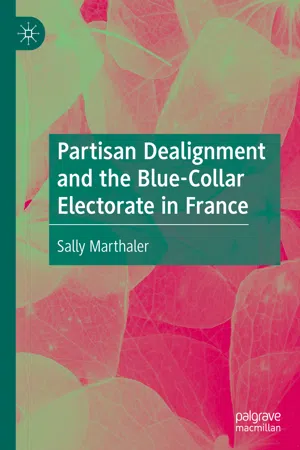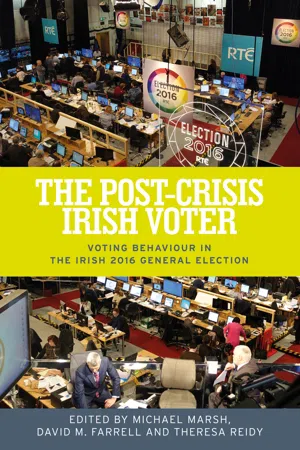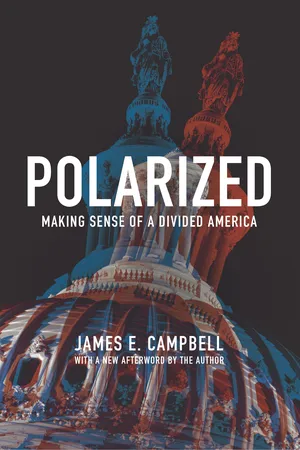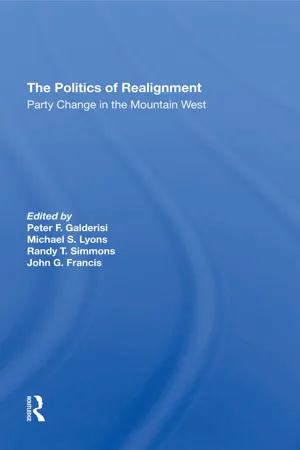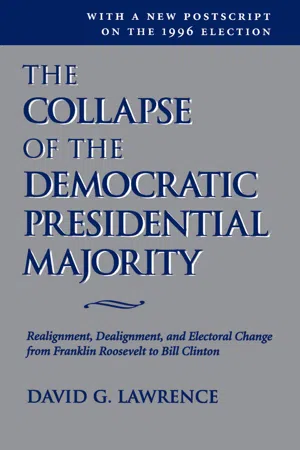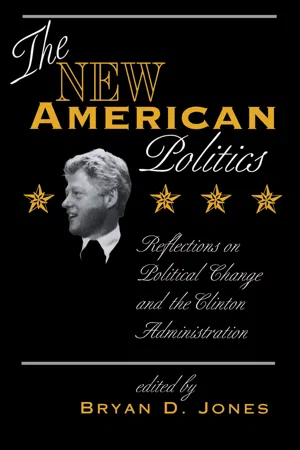Politics & International Relations
Partisan Dealignment
Partisan dealignment refers to a weakening of traditional party loyalties among voters, leading to a decline in the influence of political parties. This trend is characterized by an increasing number of voters identifying as independent or switching their support between different parties. Partisan dealignment can result in greater unpredictability in election outcomes and a more fluid political landscape.
Written by Perlego with AI-assistance
Related key terms
Related key terms
1 of 4
Related key terms
1 of 3
8 Key excerpts on "Partisan Dealignment"
- Sally Marthaler(Author)
- 2020(Publication Date)
- Palgrave Macmillan(Publisher)
© The Author(s) 2020 S. Marthaler Partisan Dealignment and the Blue-Collar Electorate in France https://doi.org/10.1007/978-3-030-35465-7_1Begin Abstract1. Introduction
Sally Marthaler1(1) School of Law, Politics and Sociology, University of Sussex, Brighton, UKSally MarthalerEnd AbstractKeywords
Partisanship Dealignment Voters Political parties Blue-collar electorate FranceThe relationship between citizens and the political elite lies at the heart of the democratic process. Partisanship, understood as a psychological bond between voters and political parties which has both cognitive and affective elements, plays a key role in the stabilisation of party systems by integrating citizens into the political order and providing parties with firm and reliable support bases. Partisan loyalties thus serve an important function in providing cues which help to structure and inform citizens’ engagement with politics and to simplify the complexities of political life. However, since the late 1960s an erosion of the traditional ties between parties and their voters has been observed in many western industrialised democracies including France.1.1 The Concept of Partisan Dealignment
Partisan dealignment,1 defined by Dalton (1984 : 233) as “a decay in the pre-existing mass bases of support for the political parties” manifested in a “decrease in the party-affiliated portion of the electorate”, is also signalled by changes in voting behaviour such as a decline in support for the established parties, falling turnout , an increase in voter volatility , and the greater electoral success of new alternative parties. The phenomenon was first observed in the USA in the late 1960s, before manifesting itself in other parts of the post-industrial world.Partisan Dealignment emerged later in France than in other comparable advanced industrial democracies and the reasons for this are illuminating in a number of ways. They shed light both on some of the general factors underlying Partisan Dealignment and on domestic political developments in France since the 1970s. While the right had been dominant since the beginning of the Fifth Republic in 1958, to the extent that it found it difficult to conceive of itself not holding power (Furet et al. 1988 ), the left-wing parties still represented a possible alternative and held out the prospect of radical change. The strength of the communist party also marked France out from most other advanced capitalist nations, as did the fact that the socialist party, unlike many of its European counterparts, did not adopt a social-democratic line until the 1985 Congress of Toulouse , and even then somewhat half-heartedly. When the phenomenon began to emerge in France in the 1980s, its principal manifestation was a loss of support for the four main parties as turnout fell and the vote for more peripheral parties increased, particularly on the radical right. This prefigured the subsequent success of populist parties in many other European democracies- eBook - ePub
The post-crisis Irish voter
Voting behaviour in the Irish 2016 general election
- Michael Marsh, David M. Farrell, Theresa Reidy(Authors)
- 2018(Publication Date)
- Manchester University Press(Publisher)
5 Party identification in the wake of the crisis: A nascent realignment? Rory Costello IntroductionMany commentators have sounded the death knell for party identification. For example, Dalton claims that we are witnessing a general process of Partisan Dealignment and that this trend ‘reflects long-term and enduring characteristics of advanced industrial societies’ (Dalton, 2002 : 29). Like many other countries, Ireland experienced a sustained period of political dealignment, beginning in the 1970s (or earlier) and continuing right through to the new millennium. In Eurobarometer polls taken in the late 1970s, approximately two thirds of Irish respondents described themselves as being close to a political party; this had declined to 40 per cent by the mid-1990s (Mair and Marsh, 2004 : 242). As reported below, just over one quarter of respondents admitted to feeling close to a party in Irish National Election Study (INES) surveys conducted in 2002 and 2007, and this fell even further in 2011.This is an important and, for many observers, worrying development. Partisanship is associated with political engagement, and is also seen by some as providing the stability necessary for a functioning representative democracy. As Rosenblum argues, ‘Partisans are carriers of a more extended story about the party than may be told by the candidates of the moment.’ Their long-term focus and attention to their party, even outside election years, acts as a ‘check on short-term, arrant, political considerations’ by their party, as well as providing support and sustenance to the party following electoral defeat (Rosenblum, 2010 : 355). A dealigned electorate, by contrast, is usually associated with disengagement, the growth of anti-establishment populism, and, above all, political instability (Green, Palmquist and Schickler, 2004 : 222; Mair, 2013 - eBook - ePub
Polarized
Making Sense of a Divided America
- James E. Campbell(Author)
- 2018(Publication Date)
- Princeton University Press(Publisher)
51 Since there had been significant growth in the 1970s of those reporting to be in the “independent leaning to the Democrats” and “independent leaning to the Republicans” categories, counting these Americans as independents inflated the extent of dealignment.The dealignment, however, was not entirely a misinterpretation of a measurement. It was real and substantial. Measuring the strength of the electorate’s partisanship as the percentage of strong party identifiers minus the percentage of pure independents, partisanship in the overall electorate dropped from about a 30% net level in the 1950s and early 1960s to about a 10% net level in the early and mid-1970s.52 This was a major development, but even in the depths of the dealignment, the electorate remained more partisan than not.There are three reasons why the dealignment was temporary, a phase in the realignment. First, the conversion and generational replacement of Democrats into Republicans required a good deal of time. People do not abandon important lifelong self-identifications easily or quickly.53 Second, as already noted, the building of a viable Republican Party in the South was a lengthy process.54 Finally, many elected Democrats were able to fend off Republican challengers through the many advantages of incumbency, from credit-claiming and constituency service to helpful gerrymandering and well-heeled campaign financing.55 - eBook - ePub
The Politics Of Realignment
Party Change In The Mountain West
- Peter F Galderisi, Michael S Lyons, Randy T. Simmons, John G Francis(Authors)
- 2019(Publication Date)
- Routledge(Publisher)
Table 4.1 conveys a clear message about the Mountain West: the Democrats have fallen from grace. There has been a marked loss, both in absolute terms and especially in relation to the Republicans, in party identification. It also appears the decline in party identification has had marked effects on voting choice, again to the detriment of the Democratic Party. It is not too much to say there has been a realignment in the region, and that the change there is both more dramatic and more extensive than change in the South. Interestingly, the Pacific West, which has undergone some of the same kinds of demographic changes as the Mountain West, does not manifest a consistent pattern of partisan change.The Impact of Party Identification
A persistent theme in the literature on partisan change in the United States is the changing meaning of party identification. Particularly among those who see dealignment as a necessary condition for realignment (Beck, 1976), party identification loses its force on individual decision making, even for those who retain an identification. For example, defection from partisan identification becomes more likely with the changed meaning of partisanship as other factors such as incumbency in congressional elections influence the choices voters make (Cover, 1977; Ferejohn, 1977). Thus, part of the process of dealignment (and therefore realignment) may be a reduced impact of partisanship on the vote as citizens turn elsewhere for cues. In light of this, it is appropriate to ask whether the changes in partisanship portrayed in Table 4.1 indicate a realignment in the Mountain West, or whether they are merely part of a general softening of partisanship accompanying the prolonged process of national dealignment.Consider first the simple correlation between party identification and voting choice (Table 4.2 ). If party affiliation was losing its meaning for voters over the time period, we would expect a decline in that correlation. Such a decline could result both from increasing proportions of independents, and from increased rates of defection. Nationally, there is some evidence of such a decline, especially in congressional voting. In the South, too, there is a decline in the impact of party identification on House and Senate voting. Again, the Rockies stand out as deviating from the national pattern. If anything, there is an increased - eBook - ePub
- Hugh Berrington(Author)
- 2005(Publication Date)
- Routledge(Publisher)
The Electorate: Partisan Dealignment Ten Years On
Ivor Crewe
In the mid 1970s observers of British elections began to revise their assumptions about the nature of the electorate. The 1970 election, it was argued, marked the close of a quarter-century of ‘stable two party voting’; the two elections of 1974 the beginning of a new era of ‘Partisan Dealignment’.1 These two labels were convenient shorthand for a series of loosely linked propositions about voting patterns and the working of the electoral system. The first referred to a relatively neat and tidy dovetailing of party, class and ideological allegiances into two electoral blocks, converted into parliamentary parties by the simple plurality electoral system. The second referred to an electorate with weaker and less cumulative allegiances which the same electoral system forced into a two-party mould only with increasing difficulty. Chart 1 summarises these two views of the British electorate.CHART 1THE ERA OF STABLE TWO-PARTY VOTING AND THE ERA OF Partisan DealignmentThe initial diagnosis of Partisan Dealignment was inevitably tentative because there were only two elections, held a mere eight months apart, on which to rely for evidence. The fact that the first of these, in February 1974, was precipitated by a double crisis of economy (the three-day week) and constitution (strikes versus government legislation) and accompanied by an unusual degree of industrial and party conflict made firm conclusions particularly difficult. There was no knowing at the time whether it signified a minor byway or major juncture in the history of British elections. Nonetheless, in electoral commentary hesitant revisionism soon turned into new orthodoxy: ‘increasing volatility’, ‘consumer voting’, the ‘decline of class’ all entered the common currency.All reports on the electorate are interim; none can ever be final. But the passing of two more general elections, in 1979 and 1983, provides an opportunity to re-examine the central tenets of Partisan Dealignment. Indeed, it offers a valuable test. Since the mid 1970s the economy has gone into deep recession, marked by burgeoning unemployment and sharp cuts in public services, and the two major parties have each moved to a more fundamentalist position. These circumstances might be thought more conducive to partisan consolidation than Partisan Dealignment. Whether this is so will emerge from examining each pair of propositions in Chart 1 - eBook - ePub
The Collapse Of The Democratic Presidential Majority
Realignment, Dealignment, And Electoral Change From Franklin Roosevelt To Bill Clinton
- David G Lawrence(Author)
- 2018(Publication Date)
- Routledge(Publisher)
Dealignment theory makes less ambitious claims: it predicts only change. In a dealigned world citizens lack the party identification anchor through which even major new issues produce stability of vote choice over time. Dealignment theory is no less precise than realignment theory on what new issues will emerge, but it is far less specific on what their effects will be and how long the effects might last. An analyst informed by dealignment theory could identify the issue at the source of Republican electoral strength in the 1980s, could observe its failure to establish the party-linked base for long-term Republican dominance, and could combine the insights of dealignment theory with some sense of economic cycles to predict that an advantage based on economic management could not last. But dealignment produces far less guidance than realignment theory about how long an individual issue will dominate the electoral agenda, how it will interact with emergent new issues, and how its period of domination will come to an end.Dealignment theory makes good sense of Bill Clinton's election as president in terms of the Republicans' economic failure at a time when they held neither an advantage in ideological issue space nor a secure foundation in mass partisan loyalties. Whether Clinton's 1992 image of moderation could survive the strains of governing, i.e., whether policy activism would inevitably rekindle an image of a governing party as ideologically extreme (as it did for Johnson after 1964 and for Reagan after 1980) was of course one of the key questions that would determine the longevity of the 1992 outcomes; so was the ability of prosperity, buttressed for the Democrats by an accompanying advantage on social welfare and class, to prove a more reliable basis for long-term Democratic success as it was for the Republicans.10Clinton's task was clearly not an easy one even before his party's 1994 debacle. Unified control of government in his first two years provided him fewer benefits than it had offered other Democratic presidents in the past: sharing a nominal party affiliation with the congressional majority no longer provides a basis for the legislative triumphs or clear legislative record it allowed Franklin Roosevelt or Lyndon Johnson. Even if the Democrats had held together well enough to allow implementation of a clear legislative program against Republican opposition, the advanced state of partisan disaggregation in the electorate made the likelihood of generating mass party loyalties that could drive elections for a generation to come would have been slim. Unambiguous personal - eBook - ePub
Financial Crisis, Austerity, and Electoral Politics
European Voter Responses to the Global Economic Collapse 2009-2013
- Pedro Magalhães(Author)
- 2017(Publication Date)
- Routledge(Publisher)
In this section we examine the changing patterns of party identification mapped above in Figure 2 more closely and potential explanations for them using a range of data sources from 1985 to 2012 (for a detailed list and abbreviations of data sources see Appendix 1). Using these sources we can see that one of the more obvious suspects in promoting this dealignment and fluidity – age – is indeed an important factor in the process. Table 1 shows that party identification has fallen most notably among younger cohorts that were socialized in the post-authoritarian era of the Third Republic. Party identification is typically a psychological attachment that intensifies throughout the life-cycle with repeated voting (see Campbell et al., 1960; Converse, 1969: 143). Thus we would naturally expect to find lower levels of this attitude among younger voters. However, the over-time evidence we assemble from three time points (1985, 1993 and 2011) suggests that non-identification found among younger people in the more recent election is more than simply a life-cycle effect.Alongside the decrease in partisanship within the Greek electorate other related symptoms of political malaise can be seen to be gathering pace over the same time period. Accompanying the decline of partisanship is an increase in the proportion of voters that are unwilling place themselves on the ideological left–right axis. Since the return of democracy in the 1970s studies have shown that Greeks were more likely to place themselves on the left–right axis than voters in other new democracies in Southern Europe, i.e. Portugal and Spain (see Freire, 2006: 158). The 1985 EKKE study reports that an overwhelming majority (91%) of the sample selected a position on the left–right axis. This declined to around 80% by 2000 (MRB, 2000) where it continued to hover for the rest of the decade (ESS 1, 2, 4). By 2011 it had dropped again, with only 74% (MRB, 2011) declaring a left–right position. While this trend can be seen to some extent as a natural outcome following the consolidation of democracy and normalization in levels of party polarization, the sharp drop after 2010 is nonetheless striking. Furthermore the relationship of age to the disjuncture is clearly notable. In 1985 the youngest two age cohorts (18–24 and 25–34) both displayed similar or higher rates of self-placement compared to other age groups (i.e. above 90%). By 2011 the figures for these cohorts have fallen markedly with only 53% of 18–24 year olds and 68% of the 25–34 age group seeing themselves as holding a left-right position (MRB, 2011). - eBook - ePub
The New American Politics
Reflections On Political Change And The Clinton Administration
- Bryan D Jones(Author)
- 2018(Publication Date)
- Routledge(Publisher)
At almost the same time, the parties also became associated with distinctive positions on foreign policy issues. International affairs had been an important item on the agenda of American national politics since the late 1930s, of course, but not in a way that involved clear and recurring ideological differences between the parties. Especially in the two decades after World War II, both parties professed to be vigorously and determinedly anticommunist; and although each party was happy to take advantage of the mistakes and failures of the other, the criticism generally had much more to do with performance and results than with basic goals or policies. Not until the late 1960s, when Lyndon Johnson had left the White House and Vietnam had become "Nixon's war," did liberal Democrats become closely identified with a foreign policy that, when compared to that of the Republicans, was less sympathetic to defense spending and military intervention and more supportive of arms control and negotiation with the Soviet Union.5. The voting coalitions of the two parties, especially at the presidential level, have also undergone significant changes. The Republicans have made substantial gains among groups that are culturally traditional (white southerners, the white working class, the devoutly religious) while losing ground among groups supportive of culturally liberal policies (blacks, the highly educated, white-collar women).A number of very good attempts have been made to trace this partisan reshuffling within the survey data on voting and party identification (see especially Petrocik, 1981, 1987). As a way of preserving some continuity with previous realignment studies, however, I will be using a somewhat more traditional method to make the point. Much of the early realignment literature, as I have indicated, looked for evidence of political change by examining the geographic patterning of the vote. When two or more elections showed a high correlation in the state-by-state results, it was seen as evidence of substantial continuity in the party coalitions. Low or negative correlations, by contrast, were a sign of major changes in the parties' base of support.
Index pages curate the most relevant extracts from our library of academic textbooks. They’ve been created using an in-house natural language model (NLM), each adding context and meaning to key research topics.
Explore more topic indexes
Explore more topic indexes
1 of 6
Explore more topic indexes
1 of 4
